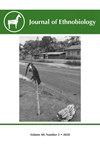Ritual Use of Ceratozamia totonacorum (Zamiaceae) Leaves in Santiago Ecatlán, Puebla, Mexico: Perspectives on Conservation
IF 1.3
3区 社会学
Q1 ANTHROPOLOGY
引用次数: 0
Abstract
This study focused on the use and management of Ceratozamia totonacorum leaves during the Day of the Dead in Santiago Ecatlán, an Indigenous Totonaca community located in the Sierra Norte of Puebla, Mexico. Ethnographical, ethnobotanical, and ecological methods were utilized to document the ritual use and traditional management practices of C. totonacorum. Additionally, this information was used to evaluate the impact and effect of leaf extraction on a C. totonacorum population. C. totonacorum plants grow on limestone cliffs and in adjacent agricultural fields. Experienced harvesters remove the leaves without damaging the plants, and when C. totonacorum leaves become scarce they are substituted by Chamaedorea spp. Our results show that these practices do not have a negative impact on the studied population. We conclude that community management practices have contributed to maintaining a stable population of C. totonacorum. We therefore consider the need to study the relationship between the permanence of ritual ceremonies and associated sustainable plant practices and the importance of projects based on a better understanding of ritual plant uses, which could contribute to sustainable resource and ecosystem conservation. This research demonstrates the relevance of co-designing comprehensive conservation strategies that vindicate the value and promote local expressions of traditional knowledge.圣地亚哥Ecatlán,普埃布拉,墨西哥:保护的观点
本研究的重点是圣地亚哥Ecatlán(一个位于墨西哥普埃布拉北部山脉的土着托托纳卡社区)在亡灵节期间对托托纳卡树叶子的使用和管理。采用民族志、民族植物学和生态学的方法,记录了托托纳多姆的仪式使用和传统管理方法。此外,本研究还利用这些信息评价了不同叶片提取对柽柳种群的影响和效果。totonacorum植物生长在石灰岩悬崖上和邻近的农田里。经验丰富的采集者在不损害植株的情况下去除叶片,当C. totonacorum叶片变得稀缺时,它们被Chamaedorea取代。我们的研究结果表明,这些做法对所研究的种群没有负面影响。结果表明,群落管理措施有助于保持白毛蚁种群的稳定。因此,我们认为有必要研究仪式的持久性与相关的可持续植物实践之间的关系,以及在更好地了解仪式植物用途的基础上开展项目的重要性,这可能有助于可持续资源和生态系统的保护。本研究表明,共同设计综合保护策略对维护传统知识的价值和促进当地表达具有重要意义。
本文章由计算机程序翻译,如有差异,请以英文原文为准。
求助全文
约1分钟内获得全文
求助全文
来源期刊

Journal of Ethnobiology
Social Sciences-Anthropology
CiteScore
4.80
自引率
3.40%
发文量
21
审稿时长
>12 weeks
期刊介绍:
JoE’s readership is as wide and diverse as ethnobiology itself, with readers spanning from both the natural and social sciences. Not surprisingly, a glance at the papers published in the Journal reveals the depth and breadth of topics, extending from studies in archaeology and the origins of agriculture, to folk classification systems, to food composition, plants, birds, mammals, fungi and everything in between.
Research areas published in JoE include but are not limited to neo- and paleo-ethnobiology, zooarchaeology, ethnobotany, ethnozoology, ethnopharmacology, ethnoecology, linguistic ethnobiology, human paleoecology, and many other related fields of study within anthropology and biology, such as taxonomy, conservation biology, ethnography, political ecology, and cognitive and cultural anthropology.
JoE does not limit itself to a single perspective, approach or discipline, but seeks to represent the full spectrum and wide diversity of the field of ethnobiology, including cognitive, symbolic, linguistic, ecological, and economic aspects of human interactions with our living world. Articles that significantly advance ethnobiological theory and/or methodology are particularly welcome, as well as studies bridging across disciplines and knowledge systems. JoE does not publish uncontextualized data such as species lists; appropriate submissions must elaborate on the ethnobiological context of findings.
 求助内容:
求助内容: 应助结果提醒方式:
应助结果提醒方式:


